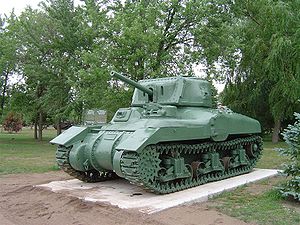| Tank, Cruiser, Ram | |
|---|---|
 Early production Ram Mk II at CFB Borden | |
| Type | Cruiser tank |
| Place of origin | Canada |
| Service history | |
| Used by | Canada, Netherlands |
| Wars | Second World War |
| Production history | |
| Designed | 1941 |
| Manufacturer | Montreal Locomotive Works |
| Produced | November 1941 – July 1943 |
| No. built | 2,032 |
| Specifications (Ram Mk II) | |
| Mass | 65,000 lb (29 t) |
| Length | 19 ft (5.8 m) |
| Width | 9 ft 10 in (3.00 m) |
| Height | 8 ft 9 in (2.67 m) |
| Crew | 5 (Commander, gunner, loader, driver, co-driver/hull gunner) |
| Armour | 25–87 mm |
Main armament | QF 6 pdr Mk III 92 rounds |
Secondary armament | 3 × .30 in (7.62 mm) machineguns (Ram I 4,715 rounds, Ram II 4,440 rounds.[1]) |
| Engine | Continental R-975 9-cyl radial gasoline engine 400 (298 kW) |
| Power/weight | 12.3 hp/ton |
| Transmission | Borg-Warner clutch, controlled differential |
| Suspension | Vertical volute spring |
Operational range | 232 km (144 mi) |
| Maximum speed | 25 mph (40 km/h) |
The Tank, Cruiser, Ram was a cruiser tank designed and built by Canada in the Second World War, based on the U.S. M3 Medium tank chassis. Due to standardization on the American Sherman tank for frontline units, it was used exclusively for training purposes and was never used in combat as a gun tank. The chassis was used for several other combat roles however, such as a flamethrower tank, observation post and armoured personnel carrier.
- ^ Hunnicutt, R.P. (1978). Sherman: A history of the American medium tank. Presidio Press. pp. 535–536.